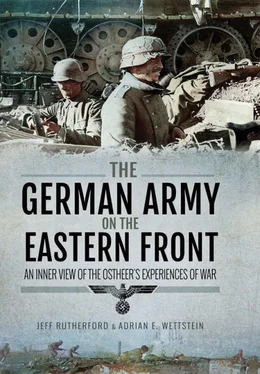Based on particular circumstances, which are thoroughly positive with reference to the larger situation, the use of ammunition must be even more keenly limited from now on than has so far been the case.
The following is ordered for the prevailing combat situation:
Infantry munitions:
1) Infantry munitions of every kind are preferably not to be used during the day.
2) ATG 3.7cm high explosive shells are only to be used in defence against enemy attacks. The munitions quantity approved for training remains the same.
3) The use of 8cm mortar shells is as of now only approved for the battle group Velizh (1st Jäger [15]Btl.) and even here only after daily query by the divisional quartermaster section for those [fired during] night to smash enemy attacks.
4) Fire on especially worthwhile targets is to be carried out with light infantry guns. Use of heavy infantry guns only with approval of the divisional Ia.
Artillery munitions:
1) Use of light field howitzer munitions only for identified enemy attack or deployment in at least platoon strength. (Indication: 30 shells).
2) Use of heavy field howitzer (French) munitions is only approved for individual night time harassing fire and enemy attacks above platoon strength.
3) Use of 15.2cm cannon (Russian) [munitions] in the next ten days only up to 15 shells daily, especially on rear area movements.
4) Counter battery fire only with approval of the division.
The principle must always be to use the available munitions primarily during the night.
Ammunition needed to be saved whenever possible to counter Soviet attacks, making the Germans more or less passive from an artillery perspective. Especially effective heavy infantry weapons such as the 8cm mortar or the heavy infantry gun faced such a shortage of ammunition, that these battalion or regimental weapons were allowed to fire only with divisional approval, eliminating the notion of decentralized command. Not even mentioned in the order are the so-called ‘shortage munitions’; types of ammunition such as the Panzergranate 40 with its tungsten core, which was so scarce that it was perpetually in short supply. This phenomenon was not only restricted to special types of shells, but often extended to whole calibre categories, such as the 8cm mortar grenade or the 10cm K18 shells. The order further illustrates the diversity of equipment and weapons, including French and Soviet guns, in regular divisions. In many divisions, essential parts of the artillery regiments, as well as many of the army support units with heavy artillery, could not have been armed without French or Soviet guns, such as the artillery regiments of the ill-fated Luftwaffen-Feld-Divisionen (Air Force Field Divisions), many of which were deployed in late 1942 on the Eastern front. One last point of the order has to be highlighted: even under these circumstances, munitions were made available for training. This underlines the importance given to training by the German army, a point to be discussed in more detail in chapter 6.
While production of goods and the process of ascertaining needs and distributing materials were great challenges that often overwhelmed the German military apparatus and the other agencies involved, the real Achilles’ heel of the German supply system in the east laid in its means of transportation or, more precisely, in the lack of an adequate means of transportation. The campaign in France in 1940 had already demonstrated strains in the logistic system due to transportation shortages, but the Soviet Union’s vast distances and much poorer infrastructure would devastate the German system.
As previously mentioned, the Eastern theatre had enormous dimensions. This therefore required an enormous apparatus to bring men and material to the front (or, in case of wounded soldiers and material in need of a general overhaul, to the rear). A comparison of German and Soviet rail networks highlights this fact: The Reichsbahn ran 42,000km of railways in the occupied Soviet territories (compared to some 62,800 km in the German Reich) and therefore needed 112,000 German railway employees and 634,000 Soviet auxiliaries. Added to this were Wehrmacht security units, the German police and regionally recruited militia units, as well as technical troops under military command ( Eisenbahnpioniere , railways engineer troops).
Due to the enormous distances, there was only a thin transport network in the Soviet Union. Therefore, traffic junctions were of strategic importance, an issue underestimated in German operational planning. For the Blitzkrieg campaign to be successful, these traffic junctions needed to be conquered rapidly and mostly intact. Otherwise, the advance slowed down or came to a halt, partly as a consequence of supply problems. But most of these traffic junctions were in cities, and the German spearheads – Panzer or motorized infantry divisions – were ill suited to conquer cities, especially when defended. The same was true for major river crossings, which were especially rare across broad rivers such as the Dnieper, Dvina or Don. This dilemma was never solved and was a cause of constant command friction, delays, and heavy losses in the spearheading units. The prolonged battles for Mogilev and Dnipropetrovsk were examples of the problems caused by transportation junctions in cities. [16]Poor infrastructure also applied to the quality of the roads. Most roads in the Soviet Union consisted of dirt that turned into nearly impassable seas of mud after rain or during the melting of winter snows. They were also never intended for the large number of vehicles that passed over them during the German advance. And while many railroad lines were also of lesser quality, the primary issues here were that the Soviets used a different gauge and lighter locomotives. So, if the Germans wanted to use the railway network, they needed to convert it to the German gauge or capture enough Soviet railway material (with the delaying factor of unloading goods at the German-Soviet border). By late 1941 and early 1942, the conversion, often poorly executed under the pressure of operational demands on railways that were never intended to carry the heavy German locomotives, became a constant source of problems. At the same time, the stocks of captured Soviet railway material never reached expectations. Organizational problems further hindered the efficient use of railways. It was not until spring 1942 that many of these problems were solved in most areas under German control. At around the same time, however, a new challenge arose: partisan warfare. Until the Germans left Soviet territory, their lines of communication were frequently threatened and often temporarily broken.
The German army had four means of transportation to overcome the distances and deliver the goods from Germany to the Russo-German-frontline: railways, motor vehicles, aircraft and ships, the last being a very marginal issue not further discussed here. Much has been written about railways in the east and some of their problems have already been examined. [17]Two other issues warrant a mention. First, while railways were effective in bringing forward many goods, they were not flexible enough for the new kind of operation arising from the use of mechanized formations. Second, the constant fluctuations in demand from the frontline overtaxed the agencies in charge of loading and controlling railway traffic. Additionally, the troops were not sensitive to the needs of the railways, often cannibalizing communication equipment, snow fences, supply and maintenance installations and even railway lines. Even with all of these problems – and due in no large part to the lack of motorized transportation – the railways constituted the backbone of the German supply system in the east, thereby shaping the course of German operations more often than recognized. [18]
Читать дальше






![John Stieber - Against the Odds - Survival on the Russian Front 1944-1945 [2nd Edition]](/books/405234/john-stieber-against-the-odds-survival-on-the-russian-front-1944-1945-2nd-edition-thumb.webp)





